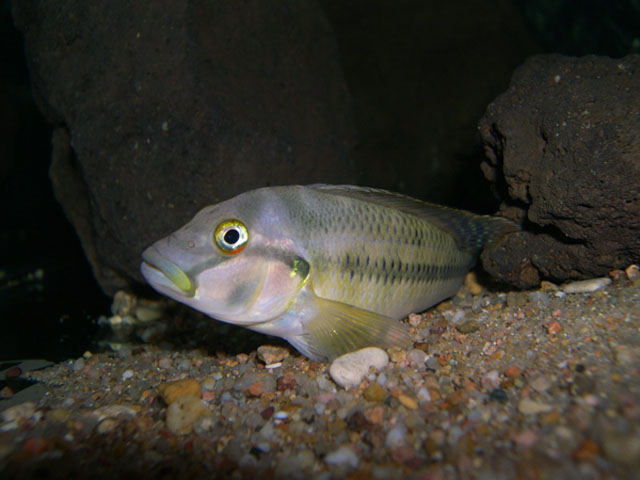| Cichlidae (Cichlids), subfamily: Pseudocrenilabrinae |
| 10.2 cm TL (male/unsexed) |
|
benthopelagic; freshwater |
| Africa: rapids at the exit of Pool Malebo (Ref. 26626), and the Lindi (Ref. 26626, 106290), Wagenia Falls (Ref. 26626, 106245), Lualaba basin and Lake Mweru (Ref. 26626), in Democratic Republic of the Congo. |
|
Dorsal spines (total): 16-21; Dorsal soft rays (total): 9-9; Anal spines: 3-3; Anal soft rays: 6-8; Vertebrae: 27-30. Description: slender, yet relatively deep-bodied; snout rounded; frontal profile slightly concave; caudal fin truncate to subtruncate; males larger than females and with a more robust head and slightly better developed (larger) unpaired fins and pelvic fins; pelvic fins rounded in both sexes (Ref. 52307). Cheek squamation, 1-3 rows of scales; chest squamation, minute, deeply embedded, often with bilaterally scaleless area; nape and nuchal scales smaller than polyacanthus, deeply embedded, appearing naked (Ref. 26626).
Coloration: body grayish-brown to olive, paler ventrally; dark longitudinal band at mid-body; at times 7 dark vertical bars may be visible; black stripe from eye to corner of mouth, another from posterior edge of eye to posterior edge of opercle; males without egg spots in anal fin; when courting, entire body paler, nearly yellowish (Ref. 52307). |
| Rheophilic; mainly feeds on algae and aufwuchs, animal matter is rarely taken; polygamous, ovophilic, maternal mouthbrooder (Ref. 52307). |
|
Least Concern (LC); Date assessed: 16 February 2009 Ref. (130435)
|
| harmless |
Source and more info: www.fishbase.org. For personal, classroom, and other internal use only. Not for publication.

